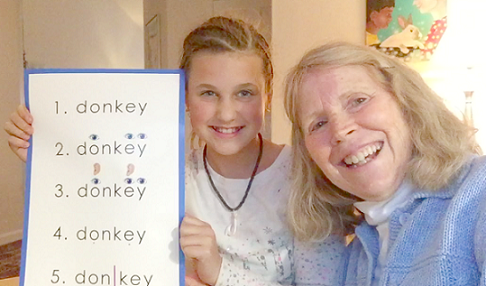She Shared How the Letters and Words Moved
I had no idea how the sweet, shy girl who walked in my door would open my eyes and stop me in my tracks.
Today Josie’s a bright, happy, full of life, confident young teenager. She often makes me giggle while we are working together. She is not the person who walked my door.
Josie began tutoring with me because she struggled with reading, writing and spelling. At that time, she was so painfully shy that she could barely lift her eyes to look at me—her self-confidence was rock bottom.
It was obvious after visiting with her for just a few minutes, that she is a bright, intelligent girl. I knew I could help her, and so our journey began.
During the time we have worked together, Josie diligently persevered with a positive attitude attempting every learning task I presented to her in Phonetic Reading with Silent Elephant “e”™.
I have seen subtle changes in her as her reading, writing, and spelling skills grow. She is now a smooth, fluent reader with excellent comprehension!
I have watched her self-confidence blossom. Now her head is held high; her shoulders back as she smiles self-assuredly when I ask her to read and when I ask her questions. Her eyes meet mine with strength and confidence.
My heart bursts with pride for her every time she walks in the door.
A few weeks ago, Josie reached a place of feeling so secure in herself that she felt at ease sharing how she used to struggle in reading and learning. She shared what she sees now when she reads words and how my tutoring and Silent Elephant “e”™ has helped her.
I sat in amazement as she shared. I listened silently. My heart went out to her.
I felt that I understood much of what she was telling me and I could empathize with her, but I also felt that there was so much more she wanted to share if she could find the words (and SO much more I wanted to understand).
I asked her if she would write about her struggles to explain to me exactly what reading used to be like for her and how it has changed. I also asked her to write about her feelings. This is what she wrote:
“Prior to tutoring with Linda, when I looked at words, they appeared scrambled and jumbled. Random letters from other words on the page would combine with the actual letters within a word I was trying to read.
Linda has taught my brain how to break down words, so when I’m focusing, I don’t see scrambled or jumbled words anymore.
I am able to read and see all of the phonics rules we learned by imagining the colors we used for each rule. If I have to read a tough word, my brain will picture the color parts that I need to read the word. I also remember the colored posters that I learned for the rules.
First I look for prefixes, suffixes and root words. Next I look for where the purple line(s) will be to divide the word into syllables. I listen to the syllable parts in my head. I look for small words within the word. Usually by then, I get the word. I don’t have to do all of these steps all of the time.
I like reading more now than I used to. When I was younger, I hated reading. I would get so frustrated. I didn’t want to read.
I really liked picture books, and I loved being read to.
I still don’t like to read out loud in class.
After tutoring with Linda, I love to read. It’s fun. ELA (English, Language Arts) is my favorite subject in school now. Josie Age 13”
Are you as stunned as I to learn of all of her difficulties and challenges; that letters moved around on the page and were scrambled and jumbled? When I read her beautifully written piece, I sat amazed.
In all the time I have tutoring her I never knew that letters were moving around the page for her!
I did actually notice when Josie first began coming to tutoring with me that she was having difficulties with clarity and focusing in on words when she was reading. I asked her mom if she would consider taking her to an eye doctor. Josie did need glasses and wears them now.
The glasses do help with clarity, but they can’t stop the letters from moving on the page. What stabilized the letters on the page for Josie were the colors and the teaching techniques I use in Phonetic Reading with Silent Elephant “e”™.
Josie’s confidence and ability to share her experiences and feelings opened a giant door for me. Because of her, I am asking better questions of my struggling students. I am asking them what they are seeing on the pages. This is continuing to open doors of understanding for me.
I thank Josie from the bottom of my heart for feeling the confidence to share and helping me become a better teacher. She has helped me understand the importance of Phonetic Reading with Silent Elephant “e”™ yet again. Without Silent Elephant “e”™ she would be a painfully shy 13-year-old desperately struggling to understand her world instead of the confident, head high student who moves about her classrooms feeling in complete control of her learning.
Next time I will share the experience of two more students who answered, “What do you see on the page?” It’s eye opening.
If you are questioning whether someone in your life is dyslexic and you’re not sure what to do, feel free to contact us.
Linda Katherine Smith-Jones Nina Henson
































